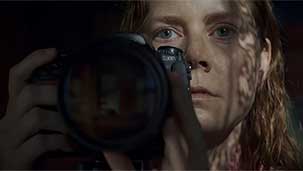Your job title sounds complicated, but it’s really quite simple: you take a low-quality version of the audio and match it with a high-quality version. Basically, you backstop the sound department, protect them when they do something quick and dirty under the assumption that it can be “fixed in post.”
You might say you’re a professional turd polisher.
The Woman in the Window could have used a lot more people like you -- in every department.
Let’s start with the source material. Much has been made of the eerie story behind the debut novel by A.J. Finn (aka Dan Mallory, aka the real-life talented Mr. Ripley) but I have no interest in litigating the author's dubious rise to fame. Fox Pictures 2000 was ahead of that trend, buying the rights to the book almost two years before it debuted at #1 on the New York Times Best Sellers list. To say the movie was rushed into production would be an understatement.
And that’s where the problems start. Even with a dramatist as skilled as Tracy Letts (more talented as a playwright than a screenwriter, it should be said), the film required extensive reshoots and a two-year delay in its release, ostensibly because they couldn’t just “fix it in post”.
Go figure, right?
Yet something clearly worked in the book to get people so excited. The material probably felt like a natural successor to Gone Girl, The Girl on the Train, and whatever other Lifetime Network woman-in-peril thrillers are given the budget to elevate them to high cinematic art. But without a Fincher or Hitchcock at the helm, these movies rarely make it past their puppy premise.
In fact, this whole film feels like a .midi file version of Rear Window. It’s a movie that tries to play all the same notes, but can’t seem to translate the combination of sounds into a rousing piece. Director Joe Wright doesn’t try to hide the influence of Hitchcock on his filmmaking; instead, it’s a shackle he tries to pass off as a necklace, as if showing the main character watching old films like Rear Window will set him free. It’s not detrimental to the film, it just feels a little sad -- less a wink to the audience than a subservient bow.
But again, stylistic influences and story parallels can be forgiven -- even celebrated -- if the emotional result still packs a punch. Unfortunately, with the exception of one well-handled reveal (paying off a dizzying establishing shot) the film mostly treads water. This is very noticeable in the heavy-lifting required by Danny Elfman’s score. There comes a point about halfway into the film where Amy Adams is walking around the house, looking out the window, into different rooms, when all the emotion was coming from the music. There wasn’t enough story or character to compel me; instead of amping up the tension, they just turned up the volume.
It’s a shame because there is no shortage of talent attached to the project, in front and behind the camera. And despite the confined space, there certainly doesn’t seem to be any budget restrictions for what can be done with the camera. But when your entire goal is to conform to a template that is already set, there’s only so much you can do to fix it.
In other words, a shiny turd is still a turd.
Sincerely,

Christopher






